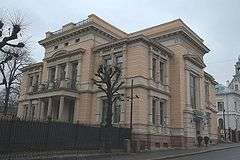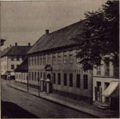Inkognitogata 18
Inkognitogata 18[1] is the official residence of the Prime Minister of Norway. It is located in Oslo, the capital of Norway. The residence was completed in 2008 and is a complex of new and old buildings. It includes the original buildings on Parkveien 45, Inkognitogata 18, Riddervolds gate 2, which have been connected with new structures, and the gardens of Parkveien 45 to 47.[2]
| Prime minister's residence or Inkognitogata 18 (Norwegian: Statsministerboligen) | |
|---|---|
 Inkognitogata 18 | |

| |
| General information | |
| Town or city | Oslo |
| Country | Norway |
| Construction started | 1996 |
| Completed | 2008 |
| Cost | 315 million Norwegian kroner |
| Client | Norwegian government |
| Design and construction | |
| Architect | Riseng & Kiehl AS Arkitekter |
| Engineer | Statsbygg |
| Parkveien 45 or 'Villa Parafina' | |
|---|---|
 | |

| |
| General information | |
| Architectural style | Italian classical revival |
| Town or city | Parkveien 45, Oslo |
| Country | Norway |
| Completed | 1877 |
| Client | Fredrik Sundt |
| Design and construction | |
| Architect | Henrik Nissen |
The Prime Minister's private residence is in Inkognitogata 18 while the official residence and government representation rooms are in both Parkveien 45 and Inkognitogata 18. Riddervolds gate 2 is the official residence for visiting foreign dignitaries. The complex totals an area of 3030 m2. Inkognitogata 18 has an area of 670 m2 with the private rooms consisting of 400 m2.[3]
The project was led by Statsbygg and the architects for the new buildings were Riseng & Kiehl AS Arkitekter while Snøhetta designed the garden. The project had a total price of 315 million Norwegian kroner.[4]
Individual buildings
Parkveien 45
Parkveien 45 used to be the official residence of the Prime Minister of Norway, but had not been used as such for many years.
The house in Parkveien 45 was originally built as a private residence for Fredrik Sundt, a businessman importing paraffin oil, hence the popular name of the house 'Villa Parafina'. The villa was purchased by the Norwegian government in 1896. From 1898 to 1908 it was used as the residence for the Prime Minister of Norway, housing Francis Hagerup, Johannes Steen, Otto Blehr, Christian Michelsen and Jørgen Løvland in succession. From 1908 the house was the residence of the Foreign minister until 1961 when it became the government representation house. The house is important in the history of Norway's independence negotiations with Sweden in 1905.[5]
Historic and former residences
- Stiftsgården in Rådhusgaten 13 (1873–1896)
- Villa Parafina (1896-1908, 1924-1931 and 1933-1935)
- Victoria Terrasse 1 (1912–1920)
- Borgenveien 12 (1965–1971)
 The Stiftsgården building, used as a residence between 1873 and 1896
The Stiftsgården building, used as a residence between 1873 and 1896- Villa Stenersen which was used as a residence in the 1970s
 Victoria Terrasse
Victoria Terrasse- Borgenveien 12
See also
- Government of Norway
- List of Norwegian Prime Ministers
External links
- Information on the project from Statsbygg: Statsbygg
- Press release from the government on the plans: www.regjeringen.no
References
- Article from Aftenposten.(Norwegian)
- Facts about the complexe Archived 2008-10-30 at the Wayback Machine (Norwegian)
- Facts about the complexe Archived 2008-10-30 at the Wayback Machine (Norwegian)
- Article from Dagbladet (Norwegian)
- History of Parkveien 45 Archived 2011-07-16 at the Wayback Machine (Norwegian)